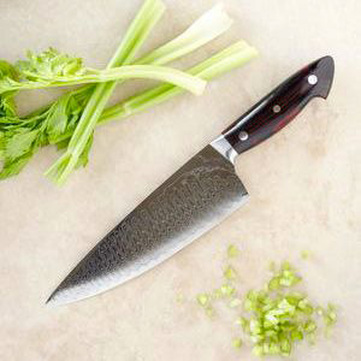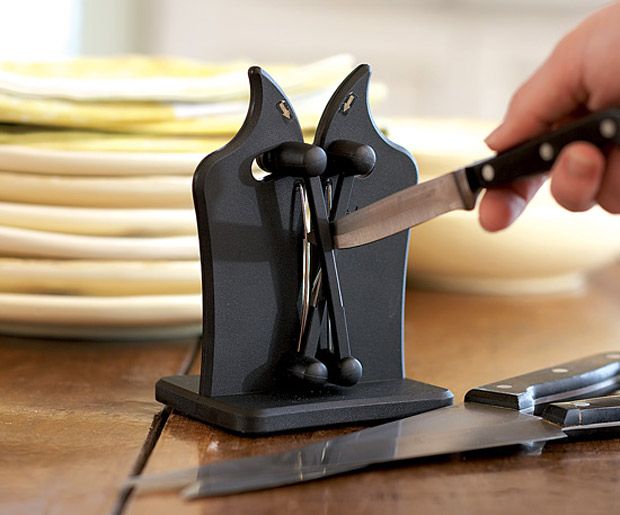
Anyone serious about cooking should be using the best equipment they can afford in their kitchen. Using good cookware has a big impact on the finished meal. It is also a pleasure to use. Of all of the implements that are used in the kitchen, chef?s knives may be the most important. They can also be the most expensive, so it is important you know which to use in your own kitchen. In most cases the brands of kitchen equipment that are the most popular with professional chefs are also the most suitable for gourmet cooks to use in their own kitchens, as well.
Choose a Brand of Professional Chef's Knives
Only a small number of cutlers around the world produce the finest quality kitchen tools favored by commercial chefs. These brands are valued for their durability and the longevity of their cutting edges. Top of the line implements can be very expensive, but buyers can find good quality substitutes that are perfectly suitable for the gourmet home cook.Two German cutlers are considered to make the finest quality knives in the world. These are Wusthof in Solingen, and F. Dick in Esslingen. Both are long-established firms with a history of supplying professional kitchens. Just below these in terms of reputation are Mundial from Brazil, and the Swiss Victorinox, well-known for their Swiss Army Knife. See: Wusthof
Decide Which Kinds of Blades You Want
What types of blades to buy depends largely on the kinds of cooking you do. Every kitchen knife is designed for specific functions. The classic chef's knife is essential because it is designed to slice and chop most of the produce used in cooking. Short sharp blades, on the other hand, are used to pare and turn vegetables. The flexible blades of filleting and slicing knives are used to debone and portion meats. Serrated edges are necessary to slice bread, and other cutting devices (like melon ballers and zesters) are useful for giving carefully-prepared dishes their best presentation.
Choose Chef's Knives that are Comfortable to Use
These are the most personal tools that any cook uses in the kitchen, so they need to be chosen by each individual to suit their own needs and preferences. When you are shopping for your knives, it is important to physically handle them. This will allow you to judge the weight of the blades, and to find the one that is neither too heavy nor too light for your strength. It will also give you an indication of how well the handle fits into your hand. You should choose the longest possible blades, since they will deal effectively and safely with a variety of cutting tasks. Knives that are too small or too light may require the user to force them, which is the most dangerous thing that can be done with any blade.
Learn Some Basic Knife Work Techniques
Because every culinary tool is designed to do a specific set of jobs, there are right and wrong ways to use them all. Learning a few of the basic cutting techniques lets you take advantage of the individual knife design and leads to the best result possible. It also gives you the confidence that you are using the right tool for the task at hand. Also, the proper techniques are designed to keep your fingers away from the cutting edge. There are many books and online videos that show the proper techniques for handling a chef's knife to use them correctly and
efficiently.See: proper techniques for handling a chef's knife.
Cooking is a favorite hobby that many people find enjoyable and relaxing. The fantastic creations of the world's top chefs are an inspiration to many home cooks, but it is impossible to replicate their results without the same equipment that they use. These top quality kitchen implements can be costly but they are also more practical and durable. Purchasing the highest possible quality gear for your kitchen is a good investment in your longer term enjoyment of the culinary arts that will continue to provide value for years.
Article source: Answers.com (http://www.answers.com/article/260744/the-best-chefs-knives-for-gourmet-cooks)
Choose a Brand of Professional Chef's Knives
Only a small number of cutlers around the world produce the finest quality kitchen tools favored by commercial chefs. These brands are valued for their durability and the longevity of their cutting edges. Top of the line implements can be very expensive, but buyers can find good quality substitutes that are perfectly suitable for the gourmet home cook.Two German cutlers are considered to make the finest quality knives in the world. These are Wusthof in Solingen, and F. Dick in Esslingen. Both are long-established firms with a history of supplying professional kitchens. Just below these in terms of reputation are Mundial from Brazil, and the Swiss Victorinox, well-known for their Swiss Army Knife. See: Wusthof
Decide Which Kinds of Blades You Want
What types of blades to buy depends largely on the kinds of cooking you do. Every kitchen knife is designed for specific functions. The classic chef's knife is essential because it is designed to slice and chop most of the produce used in cooking. Short sharp blades, on the other hand, are used to pare and turn vegetables. The flexible blades of filleting and slicing knives are used to debone and portion meats. Serrated edges are necessary to slice bread, and other cutting devices (like melon ballers and zesters) are useful for giving carefully-prepared dishes their best presentation.
Choose Chef's Knives that are Comfortable to Use
These are the most personal tools that any cook uses in the kitchen, so they need to be chosen by each individual to suit their own needs and preferences. When you are shopping for your knives, it is important to physically handle them. This will allow you to judge the weight of the blades, and to find the one that is neither too heavy nor too light for your strength. It will also give you an indication of how well the handle fits into your hand. You should choose the longest possible blades, since they will deal effectively and safely with a variety of cutting tasks. Knives that are too small or too light may require the user to force them, which is the most dangerous thing that can be done with any blade.
Learn Some Basic Knife Work Techniques
Because every culinary tool is designed to do a specific set of jobs, there are right and wrong ways to use them all. Learning a few of the basic cutting techniques lets you take advantage of the individual knife design and leads to the best result possible. It also gives you the confidence that you are using the right tool for the task at hand. Also, the proper techniques are designed to keep your fingers away from the cutting edge. There are many books and online videos that show the proper techniques for handling a chef's knife to use them correctly and
efficiently.See: proper techniques for handling a chef's knife.
Cooking is a favorite hobby that many people find enjoyable and relaxing. The fantastic creations of the world's top chefs are an inspiration to many home cooks, but it is impossible to replicate their results without the same equipment that they use. These top quality kitchen implements can be costly but they are also more practical and durable. Purchasing the highest possible quality gear for your kitchen is a good investment in your longer term enjoyment of the culinary arts that will continue to provide value for years.
Article source: Answers.com (http://www.answers.com/article/260744/the-best-chefs-knives-for-gourmet-cooks)


 RSS Feed
RSS Feed